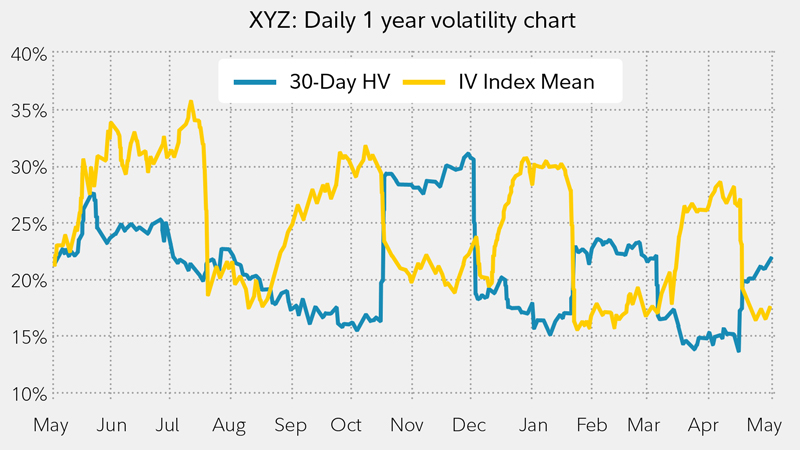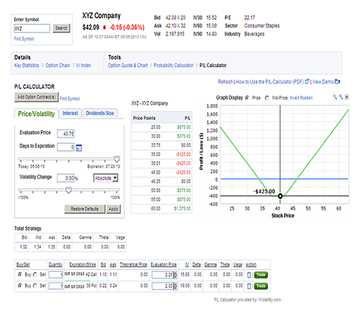What is a strangle?
The more volatile a stock (e.g., the larger the expected price swing), the greater the probability the stock may make a strong move in either direction. Like the similar straddle options strategy, a strangle can be used to exploit volatility in the market.
In a long strangle, you buy both a call and a put for the same underlying stock and expiration date, with different exercise prices for each option. The key difference between the strangle and the straddle is that, in the strangle, the exercise prices are different. In a straddle, the exercise prices are the same and normally established “at the money.”
One reason behind choosing different exercise prices for the strangle is that you may believe there is a greater chance of the stock moving in one particular direction, so you may not want to pay as much for the other side of the position. That is, you still believe the stock is going to move sharply, but think there is a slightly greater chance that it will move in one direction. As a result, you will typically pay a substantially lower net debit than you would by buying 2 at-the-money contracts for the straddle strategy.
For example, if you think the underlying stock has a greater chance of moving sharply higher, you might want to choose a less expensive put option with a lower exercise price than the call you want to purchase. The purchased put will still enable you to profit from a move to the downside, but it will have to move further in that direction.
The downside to this is that with less risk on the table, the probability of success may be lower. You could need a much bigger move to exceed the break-evens with this strategy.
Here are a few key concepts to know about long strangles:
- If the underlying stock goes up, then the value of the call option generally increases while the value of the put option decreases.
- Conversely, if the underlying stock goes down, the put option generally increases and the call option decreases.
- If the implied volatility (IV) of the option contracts increases, the values should also increase.
- If the IV of the option contracts decreases, the values should decrease. This can make your trade less profitable, or potentially unprofitable, even if there is a big move in the underlying stock.
- If the underlying stock remains unchanged, both options will most likely expire worthless, and the loss on the position will be the cost of purchasing the options.
A note about implied volatility
Because you are the holder of both the call and the put, time decay hurts the value of your option contracts with each passing day. This is the rate of change in the value of an option as time to expiration decreases. You may need the stock to move quickly when utilizing this strategy. While it is possible to lose on both legs (or, more rarely, make money on both legs), the goal is to produce enough profit from one of the options that increases in value so it covers the cost of buying both options and leaves you with a net gain.
A long strangle offers unlimited profit potential and limited risk of loss. Like the straddle, if the underlying stock moves a lot in either direction before the expiration date, you can make a profit. However, if the stock is flat (trades in a very tight range) or trades within the break-even range, you may lose all or part of your initial investment.
While higher volatility may increase the probability of a favorable move for a long strangle position, it may also increase the total cost of executing such a trade. If the options contracts are trading at high IV levels, then the premium will be adjusted higher to reflect the higher expected probability of a significant move in the underlying stock. Therefore, if the IV of the options you are considering has already spiked, it may be too late to establish the strategy without overpaying for the contracts.
In this situation, you may want to consider a short strangle which gives you the opportunity to effectively “sell the volatility” in the options and potentially profit on any inflated premiums.
Options agreement
Implied volatility rises and falls, impacting the value and price of options.

Short strangle
The short strangle is a strategy designed to profit when volatility is expected to decrease. It involves selling a call and put option with the same expiration date but different exercise prices. Keep in mind that a strategy with a short uncovered call has the potential for unlimited loss as the underlying stock price could rise indefinitely, while also still having risk to the downside, which the risk is defined as breakeven to zero (if the stock went to zero).
The short strangle is also a non-directional strategy and would be used when you expect that the underlying stock will not move much at all, even though there are high expectations of volatility in the market. As a writer of these contracts, you are hoping that implied volatility will decrease, and you will be able to close the contracts at a lower price. With the short strangle, you are taking in up-front income (the premium received from selling the options) but are exposed to potentially unlimited losses and higher margin requirements.
Long strangle example
Assume that in August, you forecast that XYZ Company—then trading at $40.75 a share—will move sharply after its earnings report the following month, and that you believe there is a slightly greater chance of a move to the upside. Due to this expectation, you believe that a strangle might be an ideal strategy to profit from the forecasted volatility.
To construct a strangle, you might buy an XYZ October 42 call for $2.25, paying $225 ($2.25 x 100). We multiply by 100 because each options contract typically controls 100 shares of the underlying stock. At the same time, you buy an XYZ October 38 put for $2.00, paying $200 ($2.00 x 100). Your total cost, or debit, for this trade is $425 ($225 + $200), plus commissions.1
The maximum possible gain is theoretically unlimited because the call option has no ceiling: The underlying stock could continue to rise indefinitely. The maximum risk, or the most you could lose on the strangle, is the initial debit paid, which in our example is $425. This would occur if the underlying stock doesn’t move much during the life of the contracts.
Strangle versus straddle
This is the tradeoff for paying $150 less for the strangle, given the expectation that there is a greater likelihood for the stock to make a sharp move to the upside. Alternatively, the stock does not need to rise or fall as much, compared with the straddle, to breakeven.
In this example, the cost of the strangle (in terms of the total price for each contract) is $4.25 ($2.25 + $2.00). Break-even in the event that the stock rises is $46.25 ($42.00 + $4.25), while break-even if the stock falls is $33.75 ($38.00 – $4.25). With this information, you know that XYZ must rise above $46.25 or fall below $33.75 before expiration to potentially be profitable, at or before expiration.
The profit/loss options calculator can help you set up a strangle trade.

How to manage a successful trade
Assume XYZ releases a very positive earnings report. As a result, XYZ rises to $48.30 a share before the expiration date. Because XYZ rose above the $46.25 break-even price, our October 42 call option is profitable. Let’s assume it is worth $6.40. Conversely, our October put option has almost no value; let’s say it is worth $0.05.
Before expiration, you might choose to close both legs of the trade. In the above example, you could simultaneously sell to close the call for $6.40, and sell to close the put for $0.05, for proceeds of $645 ([$6.40 + $0.05] x 100). Your total profit would be $220 (the proceeds of $645 less your initial investment of $425), minus any commission costs.
Another option you have before expiration is to close out the in-the-money call for $6.40, and leave the put open. Your proceeds will be $640 ($6.40 per share.) You lose out on $0.05 per share, or $5.00 (100 x $0.05) in sales proceeds, but you leave it open for the opportunity that the stock will go down before expiration and allow you to close it out at a higher premium.
Now, consider a scenario where instead of a positive earnings report, XYZ’s quarterly profits plunged and the stock falls to $32 before expiration.
Because XYZ fell below the $33.75 break-even price, the October 38 put option might be worth $7.25. Conversely, the October 42 call option could be worth just $0.10. Before expiration, you might choose to close both legs of the trade by simultaneously selling to close the put for $725 ($7.25 x 100) as well as the call for $10 ($0.10 x 100). The proceeds of the trade is $735 ($725 + $10), and the total profit is $310 (the $735 proceeds less the $425 cost to enter the trade), minus commissions.
Another option may be to sell the put and monitor the call for any profit opportunity in case the market rallies up until expiration.
How to manage a losing trade
The risk of the long strangle is that the underlying asset doesn't move at all. Assume XYZ rises to $41 a few weeks before the expiration date. Although the underlying stock went up, it did not rise above the $46.25 break-even price. More than likely, both options will have deteriorated in value. You can either sell to close both the call and put for a loss to manage your risk, or you can wait longer and hope for a turnaround.
When considering whether to close out a losing position or leave it open, an important question to ask yourself is: "Would I open this trade today?" If the answer is no, you may want to close the trade and limit your losses.
Let’s assume that with just a week left until expiration, the XYZ October 42 call is worth $1.35, and the XYZ October 38 put is worth $0.10. Since XYZ didn’t perform as expected, you might decide to cut your losses and close both legs of the option for $145 ([$1.35 + $0.10] x 100). Your loss for this trade would be $280 (the $145 proceeds, minus the $425 cost of entering into the strangle), plus commissions. You might also consider selling the call, which still has value, and monitor the put for appreciation in value in the event of a market decline.
The risk of waiting until expiration is the possibility of losing your entire initial $425 investment. You might also consider rolling the position out to a further month if you think there may still be an upcoming spike in volatility.
Other considerations
There are cases when it can be preferential to close a trade early. As mentioned, time decay and implied volatility are important factors in deciding when to close a trade. Time decay could lead traders to choose not to hold strangles to expiration, and they may also consider closing the trade if implied volatility has risen substantially and the option prices are higher than their purchase price. Instead, they might take their profits (or losses) in advance of expiration. Greeks can help you evaluate these types of factors.2
The strangle can be a useful variation of the straddle strategy for those stocks you think will make a big move and you think there’s a greater chance of it moving in a certain direction.



